Moneual MonCaso 312

Moneual MonCaso 312 ReviewIf you’ve decided to put your HTPC where it can be seen, you owe it to your eyes to put it in a chassis that makes it look like it belongs. A nice case is an essential part of any build but unfortunately are not inexpensive. The Moneual MonCaso 312 looks the part of a sleek low profile case; let’s take a detailed look at if it is worth the price and can provide a good home for your next HTPC. |
Case Impressions
At first glance it is apparent that Moneual did an excellent job of making the MonCaso 312 blend into the A/V stack, as this all aluminum case provides all the right cues to look the part of home theater in a box (HTIB) – several visitors to the “lab” even asked about the new “Blu-ray player” so it aced that test. Unlike most HTPC cases which go for the plain flat slab approach, the face plate of the 312 is a textured brushed aluminum that tapers inward at the bottom. While this texture gives the face plate a polished look, the grooves tend to collect fingerprints that are hard to remove.
 |
There are no mounts for active cooling in the 312, so good airflow is essential. Fortunately the folks at Moneual thought of that and provided ample ventilation; good planning will still be required to properly cool components so probably best to skip the 130W CPUs. Note that cooling slots are located above both the CPU and PCI slots as well as along the back panel of the case so there is an inlet for cool air for the CPU fan as well as providing some natural convection throughout. The 312 is a low profile micro-ATX case accepting a standard ATX power supply unit (PSU) which can act as an exhaust fan (PSU with 120mm intakes will not ventilate the case). The slots are nice for cooling, but allow any noise from inside the case to escape and make it difficult to apply sound damping materials (like PaxMate) effectively. They also make it difficult to install the I/O shield because the area directly above the shield is not rigid and flexes quite a bit when inserting the shield.
 |
 |
There are also slots located on the right and left sides of the case where the hard drive mounts are located.
 |
As well as on the bottom of the case beneath both hard drive mounts.
 |
The PSU I used was an Antec Earthwatts 380 which uses an 80mm intake fan located in line with the 80mm exhaust fan, but the 312 can accommodate a PSU with 120mm intake as well (the intake fan will draw air from underneath the case).
 |
Pressing “Open” on the front panel reveals the headphone/microphone jacks (the case supports HD front panel audio and the AC-97 header on the same cable), a firewire connector, two USB ports and a card reader supporting CompactFlash (CF)I/II, Memory stick, MultiMedia (MMC), MicroDrive, SecureDigital (SD) and SmartMedia. Oddly missing, although perhaps not give the CE nature of the case, was a hard drive activity indicator — although the manual seems to indicate that it should be located with the IR sensor. Two LED lamps are present to the left of the card reader to indicate power and activity for the slots which are presented as a discrete removable disk in Windows.
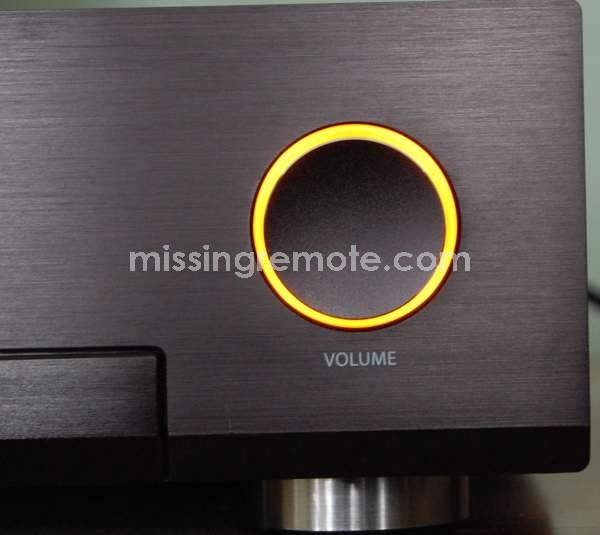 |
Instead of a traditional power LED (the case doesn’t have a wire to connect to the power LED header), the 312 has a set of four bright white lamps located behind the volume knob that push light through a piece of orange plastic. The light isn’t bad at all during the day, but I expected it to be a problem in low light conditions.
 |
While it was a bit distracting at first (this picture was taken at night with very low light and no flash), it was not nearly as bad as I feared. For those who dislike the orange light, Moneual will provide the blue disc which comes with the silver version of the case free of charge (thanks to mikinho for pointing this out). Just contact them through their website and they will send it out, even covering the cost of shipping.
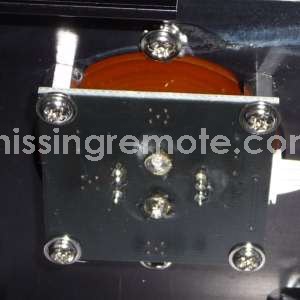 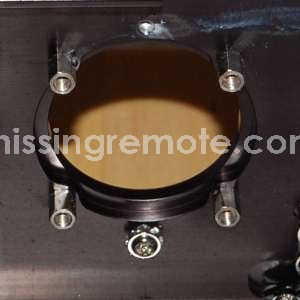 |
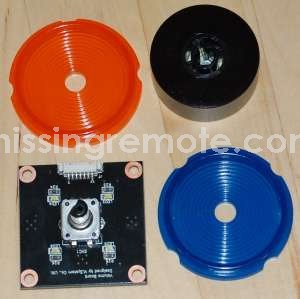 |
Swapping the disc is relatively straightforward, just remove the four screws attaching the assembly to the case and gently pull the knob off the base (some rocking was required to loosen it). Then put the blue disc on and reverse the procedure.
 |
The blue disc traps more light than the orange, so it reduces brightness in addition to providing (in my opinion) a slightly better look. The volume control works pretty well for audio decoded on the PC and pressing it toggles mute. In most of the testing the PC was connected to an AVR via HDMI with it controlling audio volume, so the knob was mostly ornamental. But in a standalone environment (where all audio was decoded on the PC) it is a nice to have; either way it adds to the CE look of the case helping it blend in.
Install
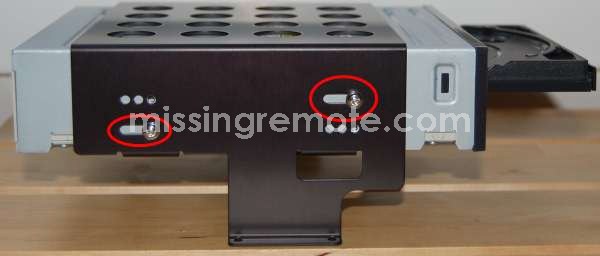 |
Like many slim HTPC cases the 312 comes with a metal bezel to attach to the Blu-ray (BD) drive tray (after removing the stock one), and hides the body of the drive behind the front panel. There is a small button in the front of the case that is supposed to make contact with the drive’s eject button, but does not always. Two BD drives were tested in the chassis; an LG GGC-H20L worked as intended (although the button’s feel was very soft), but with a LITEON iHOS104-06 either no contact could be made with the external button without the drive’s eject button making contact with the case (which made the drive open and close randomly). Applying a small piece of double-sided 3M foam tape (about 1/8” thick) to the external button resolved the issue as well as providing a more solid feel to it versus the LG drive. To get the proper distance, I found it much easier to remove the hard drive brackets and use the screw slots in the BD drive mount (circled in red above) to install and position the drive inside the case.
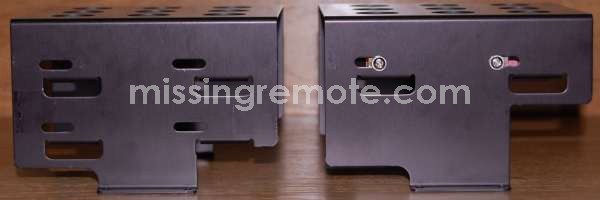 |
Two hard drive mounts are included supporting a total of 3 drives. The mounts are interchangeable so technically it should be possible to find another mount (or modify the single HD one to support two), but space is tight in the case so I ended up leaving one out (more on this below). Given that there is no active cooling in the case and that the all aluminum case construction tends to make noise amplify as it rattles around inside, the fewer hard drives the better.
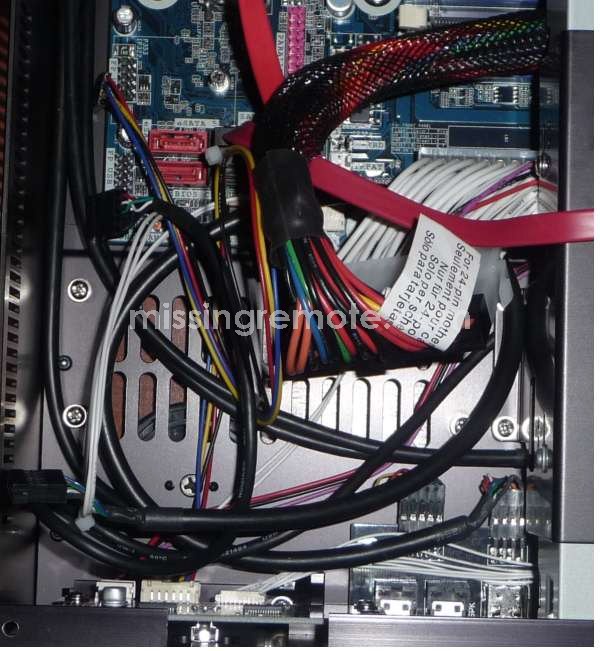 |
To power the IR receiver and power LED a 24-pin ATX power extension is required (white cable circled in red above). While this enables features like wake from soft-off (S5) and hibernate (S4) it takes up valuable real estate inside the case and ended up blocking installation of one of the HD brackets. The severity of this issue is dependent on where the board’s power connector is, while slightly annoying this was mostly a non-issue for this board; had the power connector been slightly farther to the right (underneath the BD drive) it would have been a much bigger problem.
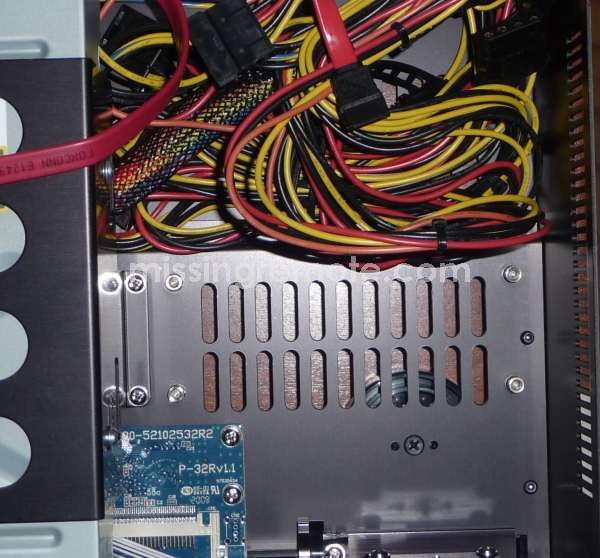 |
The other side was only a bit better with little space to store all the extra cables from the standard ATX power supply unit (PSU). I was able to use the two drive mount in this location with two drives, but it required some force to get everything in nicely. Opting for a picoPSU or modular standard ATX would minimize the potential for issues.
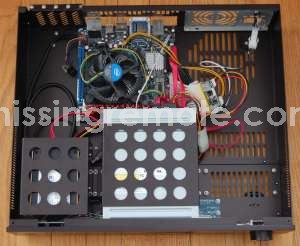 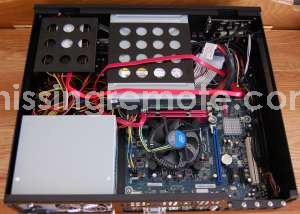 |
As noted earlier there are no mounts for active cooling, but even the bottom of the case has plenty of air intake slots so no heat issues were noted in either of the builds attempted in the case.
The only major issue encountered with the case appeared when attempting to install TV tuners with multiple coaxial inputs because of interference with the case. The severity of this issue varied between cards, as I was not able to install a Hauppauge HVR-2250 with the retention bracket attached, but the AverMedia M780 would go in with some coaxing.
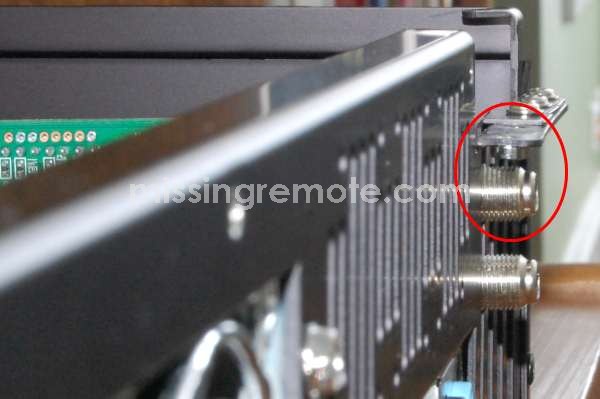 |
It was possible to get the HVR-2250 in by removing the bracket (not recommended), but even in that scenario the case interfered with the top input making it very difficult to use a coaxial cable with a screw on connector.
Remote & Software
The 312’s integrated FTDI based IR receiver is a great feature as it removes the need for an external USB device. The only drawback I found with the hardware is that the eye is somewhat recessed so it does not work reliably at sharp angles, but that was never an issue under normal use.
 |
 |
 |
The included remote is functional and includes keys for all of the basic Windows Media Center activities as well as several others that enable more granular control. The unit is somewhat flimsy and has a very cheap feel to it; that said OEM remotes tend to only get used to train my Harmony* so that wasn’t really an problem. The remote is functional, but I suspect that it will not age well especially if there are children around.
* For those planning to use a Harmony remote with the 312 it is a VL Systems M-Play 202
To make the remote useful it is necessary to install the M.Play MX application included with the case. The application lacks polish but is actually quite rich in functionality, allowing for remote based application launching from the “Quick Guide” and complete control over what each key press actually does at both a “Basic Key” level and per focused application.
 |
Creating custom key mapping definitions is tedious, but quite easy. Fortunately M.Play includes definitions for several popular HTPC programs like Windows Media Center (MC), Power DVD and Total Media Theater.
In most cases remote keys will map to single or multiple (e.g. Control-Shift-F) simulated key presses on the PC, and generally works quite well. One exception to this is triple-tap inside of MC where the number keys are interpreted as number keys instead. I reached out to a contact at Microsoft to see if there are any workarounds, but for now it’s just something to live with.
For more complex tasks it’s also possible to run applications that perform actions like send windows messages to applications that don’t present keyboard shortcuts for every supported action (Sage documents the supported messages in the user manual). The definitions are stored as .MPK text files in the user’s application data store (C:\Users\username\AppData\Local\M.Play MX\MPK) so they are user specific, but because they are file based are easy to backup and share. I’ve uploaded my personalized definitions for PDVD9, TMT3, Media Center and SageTV Client (the server would need a slightly different mapping for the Windows messages); but applying them can be a bit tricky. There may be an easier way but I found the most reliable was modifying the existing definition (or create a new one), then closing the application and pasting the .MPK files into the folder where they are stored.
Windows Media Center IR receiver and remotes are great because they are cheap and work very well, but the lack of discrete power on/off codes makes programming true one-touch macros impossible because you can’t risk putting the PC into standby. One of the cool things about the 312’s integrated remote is that this issue is addressed because there are discrete buttons for Power and Sleep on the remote.
As noted earlier the “Power” button can turn the PC on from soft-off(S5), hibernate(S4) and wake from standby (S3) so adding it into the Harmony macro make perfect sense no matter what scenario. Once the PC is on the default behavior is to display the M.Play “Power Manager” shown above when “Power” is pressed.
But we can override this behavior easily by remapping the key in the “Basic Key” area to do nothing and we have our discrete on/off IR codes.
Conclusion
It’s hard to beat the flexibility and capability putting a HTPC in the A/V stack enables; having taken that step, the PC needs to look like it belongs there. All aluminum construction, an integrated remote and attention to detail are not cheap; and the 312 isn’t either with a street price of $230-$240. While I wish it were less, compared to other cases in the same space and similar construction the price is very competitive especially considering the built in IR receiver. Selecting any low profile cases will require some compromise and I suspect that the Moneual MonCaso 312 is a bit more demanding than most, but it’s hard to argue with the excellent build quality and design that make it fit perfectly in the home theater.
Pro:
- CE look
- Excellent build quality
- Discrete IR
- All aluminum construction
- Built in remote and flexible software to manage key mapping
- Plenty of ventilation
- Excellent customer service
Con:
- Hard to dampen noise
- Cost
- No triple-tap in Windows Media Center
- Interior somewhat cramped
- Issues installing TV tuner cards
- No active cooling options
